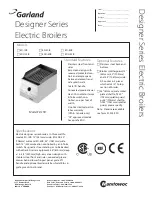
55
Response 80 / 100 / 120
- Installation
FAULT FINDING
85
Flame detection and mixture
WARNING. When panels are removed for service, live parts are exposed so caution should be exercised when fault-finding.
Foot Note: POLARITY CHECKS
Use a multimeter (set to measure 230 V AC or more), connecting the black lead to a reliable
Earth point (not Neutral for this
particular test).
You should find 230 V on terminal L and zero (or a small reading) on terminal N.
N.B.
Some meters may trip residual current devices during this test.
Remove the fan.
Is the detection lead undamaged and
attached to the (single) detection electrode
terminal at the rear of the burner base ?
Check detection lead for continuity.
Check that the electrode is in the flame area
and within 7mm (± 1mm) of the burner at
closest point.
Rectify any fault.
Does the boiler now run ?
YES
Is this a new installation ?
Has any electrical work been done to the
boiler or the house wiring ?
YES
Check the polarity of the incoming mains to
the boiler (see footnote).
Is this correct ?
YES
Check the polarity of the mains input to
PCB 41 when the fan starts.
Is this correct ?
Does the boiler now run ?
Remove the burner assembly.
Check the detection electrode visually for
damage / contamination / moisture.
If possible, check insulation resistance
between the electrode and earth with the lead
disconnected - this should be at least 100
Megohms.
Is it OK ?
NO
NO
YES
YES
NO
Check all connections on PCB 41.
Check for moisture on PCB 41.
If no fault found, check PCB 41 by substitution.
YES
EXIT
YES
YES
YES
NO
Boiler does not light, or lights briefly
at the
correct burner pressure then
goes off, leaving LED 2 on PCB 41 lit
Check that the gas injector is unobstructed.
F
AUL
T FINDING
Summary of Contents for responce 100
Page 1: ......
Page 62: ...62 Response 80 100 120 Installation NOTES ...










































